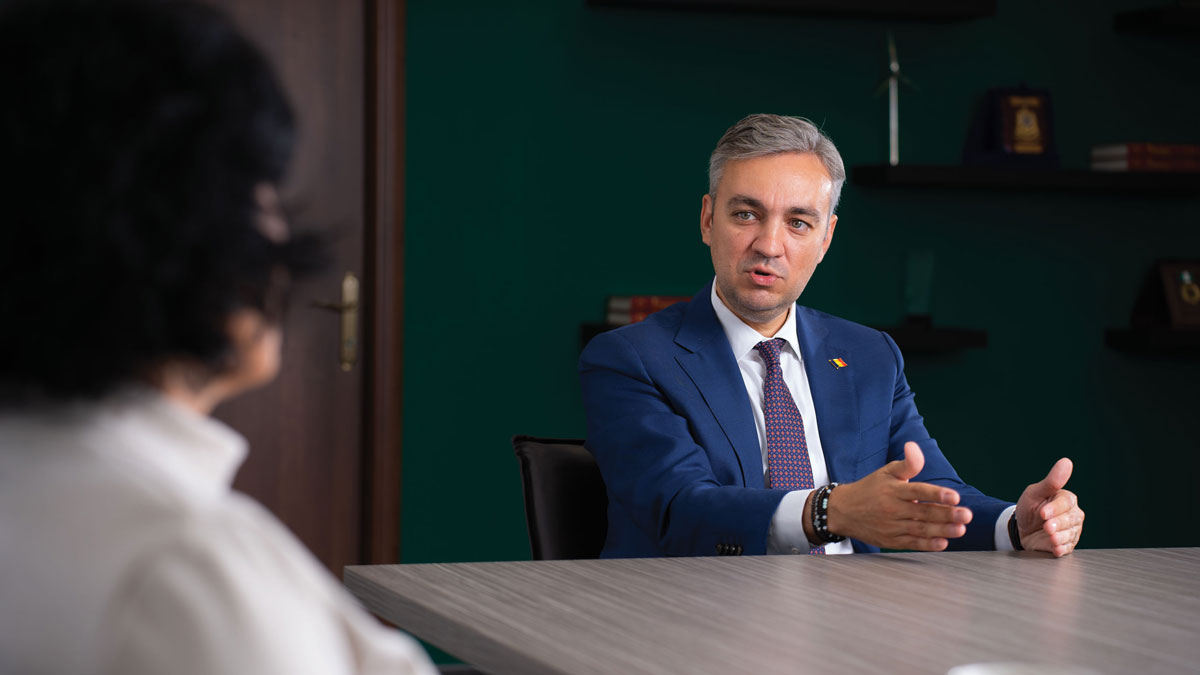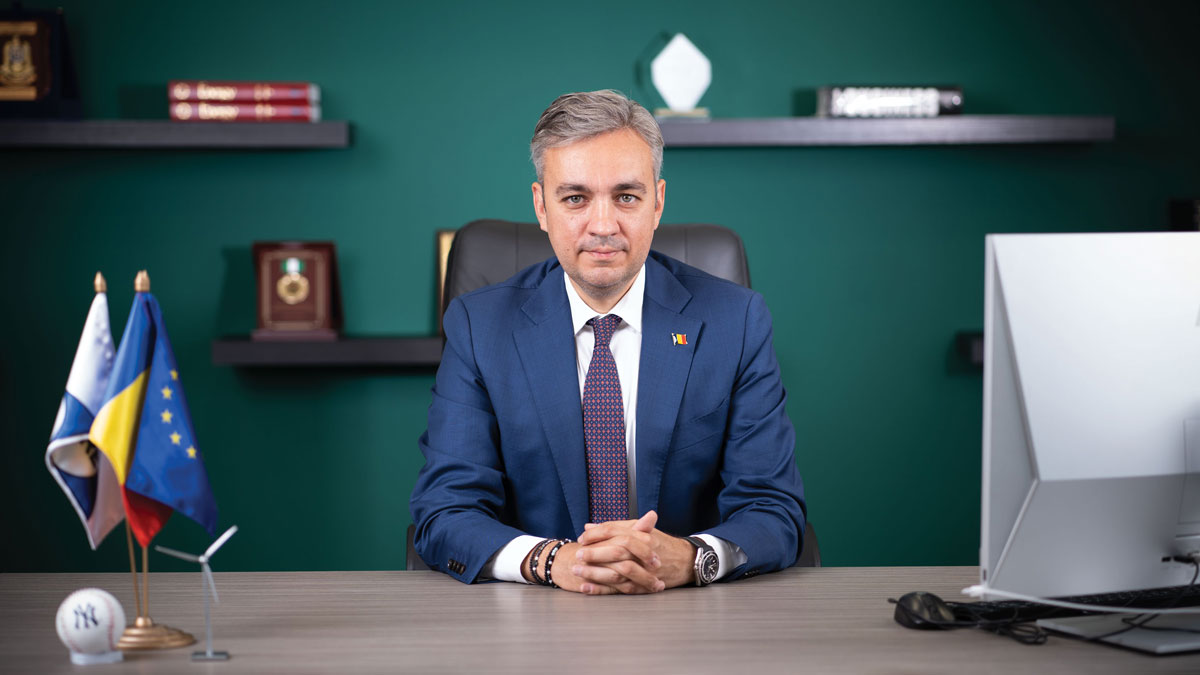George-Sergiu Niculescu, President of ANRE: Romania Paving the Way for Investments in Offshore Energy
George-Sergiu Niculescu is, as of April 2023, the new President of the Regulatory Committee of the National Regulatory Authority for Energy (ANRE), while holding the position of Secretary of State in the Romanian Ministry of Energy. In our dialogue, the official assesses the local energy market compared to similar markets in the region, while exploring possible approaches to ensure a high degree of competitiveness in line with the needs of the local and regional energy community.
Mr. Niculescu, you are at the beginning of your mandate, and you come after an important experience in the Ministry of Energy, where you represented the Government in negotiations for Romania’s energy security. And since you have recently attended a series of official meetings in the United States, I’d like to start with this very topic.
George-Sergiu Niculescu: My term at the Ministry lasted over two years, and coincided with an eventful period of global, European and national change. As Secretary of State in the Ministry of Energy I had the opportunity to contribute to important energy strategies and projects. The experience gained in this capacity is extremely valuable and I think anyone who worked at the Ministry of Energy at that time feels the same way.
Coming back to the present, during July 5-16, 2023, I was in the United States of America, in Washington, Boston and New York on a working visit on offshore wind energy. ANRE was invited to participate in this event by the United States Department of Interior, in the framework of the International Technical Assistance Program, together with representatives of the Ministry of Energy, CNTEE Transelectrica SA and ACROPO.
Please detail the meetings a bit, to make it as clear as possible for our readers.
George-Sergiu Niculescu: A good idea. From a journalistic perspective, if you will, official meetings in the US fall into two categories. We have had meetings with the administrative-governmental area on the one hand, and meetings with actors from the private sector, from the analysis and private research environment, on the other.
In the administrative-governmental area, we had very good working meetings at the Department of Interior (DOI), where representatives from the Bureau of Ocean Energy Management and the Bureau of Safety and Environmental Enforcement presented the institutions that are involved in the permitting process for offshore wind projects, the role of each and the standards for each operation.
An interesting meeting was held at the National Oceanic and Atmospheric Administration (NOAA), a government agency that works to understand and predict changes in climate, weather, ocean, and coasts and provides this information to promote marine and coastal conservation. We spoke to scientific advisors Adena Leiban and Mark Monaco and James Morris, who is responsible for marine planning. In particular, there was discussion about the rules that need to be respected when developing offshore wind farms, so that they do not impact the environment.
At the State Department we spoke with Principal Deputy Assistant Secretary Laura Lochman. We analysed the energy sector in Romania, with a focus on the offshore wind development project. At the State Department, we also discussed regional challenges in the geopolitical context, sharing our own expertise.
We spoke to John Begala, Vice President of the federal agency ITA – International Trade Administration, about how to attract investment.
Another highly technical meeting was with experts and consultants of CLDP – Commercial Law Developing Program, where in an extensive format the legal and institutional framework necessary for the development of the offshore wind industry was analysed.
Another very good meeting, in an extended format, took place at DOI, where we were joined by experts from the US Department of Energy. In this format, we discussed how we can provide a framework for the development of renewable energy, the development of the transmission grid and the hydrogen industry.
Also, at DOI headquarters, I had the pleasure of speaking with experts from the Federal Energy Regulatory Commission (FERC) and listening to a presentation by government expert Sarah McKinley.

These were meetings at the federal level, at the level of federal departments and agencies. You also posted on social media about meetings with the administrative-state area, a more applied area because we are talking about institutions responsible for the direct implementation of energy projects.
George-Sergiu Niculescu: That’s right, I also wanted to see the experience at the US state level. I shy away from saying experience at the local level, considering that some American states have a higher GDP than some European countries or Russia.
One such working meeting was with representatives of the New Jersey Economic Development Authority (NJ EDA), an independent state agency that aims to grow the local economy through job creation, local investment, and community development. NJ EDA runs tax credit programs, procurement programs and partnerships with academia.
Another meeting on this area was with the team from the New Jersey Board of Public Utilities (NJPBU), a state agency that regulates utility companies that provide service in the area of natural gas, electricity, water, telecommunications and cable TV.
A highlight of the visit to the US was a meeting with experts from the New York State Research and Development Authority (NYSERDA), an institution set up to serve the interests of both the state and private companies. Here we spoke to Gregory Lampman, Director of Offshore Energy, about how the energy sector is being managed in one of America’s richest and most developed states. The Romanian side was particularly interested in how the offshore wind projects being implemented in New York State are connected. The American experts explained how important predictability and stability is for the Romanian energy sector.
In turn, the meetings with representatives of the private sector and the research area were also very good, as we also got a better understanding of the perspective of energy investors, the problems they face and how the industry will look in the future. One such meeting took place in Boston, where we attended the most important offshore wind conference – ‘US Offshore Wind 2023’ an event where the technological trends and answers to the future challenges of this industry are presented.
Let’s stay within the international framework for now. Considering the issues of major interest for the Romanian energy system, how do you rate the Romanian electricity market compared to similar markets in the region?
George-Sergiu Niculescu: Before I tell you my view, I think it is even more important to tell you the perspective of our American partners. And their strong message was that they are confident in Romania’s path. They told me that as a nation we have every chance to turn our advantages and opportunities into real success and become a regional model of development. Obviously, to achieve these goals we need predictability and stability – these things are non-negotiable if we are to take concrete steps in the right direction.
I share the perspective of our friends. It is clear that the electricity market in Romania is a mature market operating in line with European regulations on the internal energy market, environmental policy, integration of balancing markets, and interconnection of energy systems.
Romania has significant generation capacity to support domestic consumption, a balanced electricity mix by resource type and is following the trend of decarbonisation and strong and sustainable growth of renewable generation capacity, through fine-tuning related to improving market mechanisms, as well as encouraging the investments we are always looking at.
ANRE has approved regulations related to the wholesale electricity market which mainly aimed at developing transparent regulations for the allocation of interconnection capacities between Romania’s bidding zones and adjacent non-EU member states, simplifying the organised electricity contracting framework for large final electricity customers and simplifying the organised electricity contracting framework.
In the recent complicated regional context, if we only refer to the invasion of Ukraine, the EU energy market has undergone profound structural changes. What approach can Romania use to help diversify supply sources, maintain a safety margin, and interconnect Europe’s energy networks?
George-Sergiu Niculescu: From a geopolitical point of view, we can see that European states have acted firmly and immediately to ensure that European citizens and European companies do not suffer from the invasion of Ukraine. It is clear that we are in a different paradigm today than we were a year and a half ago. No European state can rely on hydrocarbons from Russia anymore, it is obvious that we can no longer accept Russian blackmail and the use of energy as a foreign policy tool. Romania was part of the decision-making process in Brussels, and I believe that the decisions made are beneficial both for the EU bloc and for our country.
Romania already had plans to develop new power generation capacity, and the Russian invasion only increased the speed at which we were implementing these things. Romania intends in the near future to pave the way for investments in offshore energy production by adopting the necessary legislation and regulations for the installation of offshore wind power plants with a total installed capacity of 3 GW. ANRE will have an important role in authorising these projects and in adapting the regulatory framework dedicated to supporting projects through the use of contracts for difference.
In relation to the interconnection of the Romanian electricity system with the European one, ANRE’s activity focuses on the implementation of the provisions of the European regulations for the creation of a coordinated European system and the development of the capacity of the interconnection lines. In this respect, ANRE specialists participate with European specialists in the development of the common regulatory framework.
In terms of capacity, Romania aims to reach in the future the minimum level of interconnection capacity available for international trade, i.e., 70% of transmission capacity, as provided for in Regulation 943/2019. We will do this through the transmission and system operator, and the projects will be both with neighbouring countries and national projects to upgrade and strengthen the power grid.
Regarding the transition to the gas-hydrogen mix, in line with the European strategy, we have asked Transgaz S.A. to carry out studies and pilot projects in the coming period to establish the necessary conditions. In this respect, we have recently approved the Rules necessary for the adoption of the Hydrogen Code which is a starting point for the conversion of natural gas distribution systems to natural gas and hydrogen mixture or hydrogen only. The regulation also has a significant impact on end-consumers as it starts the process of decarbonisation of the gas distribution system, with an impact on reducing the cost of energy consumed. The hydrogen that will be introduced into the networks will be “green”, produced from renewable sources.

What is ANRE’s vision of national and international developments in the field of energy, climate change, sustainability, energy transition?
George-Sergiu Niculescu: 2022 was a year that put Europe’s energy system to the test. International developments have triggered energy market reactions that have led to price increases and the need for protective measures at both European and national level. At European level, we are currently working with Member State experts to develop an improved market model. The model will be finalised next month and submitted to the European Parliament for approval. At the national level, the mechanisms established by the Romanian Government and implemented with the help of ANRE have focused on setting price caps for consumers of different categories and by establishing a mechanism for centralised purchase of part of the energy for consumption.
Given its scope of activity, ANRE will continue to provide the regulatory framework designed to encourage investment projects that contribute to the diversification of Romania’s energy sources, to interconnection with European systems, and to stimulate investment interest in upgrading and modernising existing energy capacity and in developing new production capacity to ensure security of energy supply for the benefit of end-consumers.
The energy sector, both at European level and in Romania, is in the process of transition towards clean energy. How does this process manifest itself in Romania, what are the benefits and what are the negative effects?
George-Sergiu Niculescu: The European Commission presented this year the REPowerEU plan to make Europe independent of Russian fossil fuels by 2030. The Commission proposes to increase the 2030 target for the share of renewables in total energy consumption in the EU from 40% to 45% as part of the ‘Fit for 55’ package. At the same time, Romania has committed itself to important objectives through the ‘Integrated National Energy and Climate Plan 2021-2030’. Romania will maintain its position as an energy producer in the region and as an active and important player in the transition towards a greater share of renewable energy sources in total energy consumption.
In order to secure energy consumption, installed capacity will increase by around 35% by 2030 compared to 2020, due to the deployment of new wind (2,302 MW by 2030) and solar (3,692 MW by 2030) capacity. This will lead to an increase in domestic energy production, thus ensuring a higher level of energy independence. The advantage for us is that even today Romania has one of the lowest energy import dependency rates in the EU.
In order to facilitate a transition to a decarbonised and sustainable energy system, we have approved at ANRE the Rules necessary for the adoption of the Hydrogen Code, which is a starting point for the conversion of natural gas distribution systems to a natural gas and hydrogen mixture or hydrogen only.
How can consumers, both household and industrial, be protected from the impact of the energy transition?
George-Sergiu Niculescu: The European Union has entered an unprecedented decarbonisation race, we are in a new era unimaginable just two or three decades ago. On this road, Romania as a Member State must choose solutions that will generate opportunities for economic growth and, at the same time, identify solutions to limit the impact of the energy transition on consumers. This transition is important, but it is clear that it can only be done in agreement with European citizens.
The energy transition is an opportunity for structural change in which consumers have a key role to play. The role of consumers and their integration in the energy transition is now seen as essential, both for understanding, acceptance, and financing of the necessary measures and for encouraging active participation. This will require changes in behaviour, for example in the way energy is produced and consumed. Consumers can contribute directly to reducing carbon emissions, for example by buying energy-efficient homes, using energy-efficient appliances, or producing energy from renewable sources.
More than ever there is a need for a fundamental change in the role of consumers in the market and it is important that they are given the opportunity to adapt their energy consumption to take advantage of real-time changes in supply and demand.
Of similar importance is ensuring a regulatory framework that allows consumers the freedom to produce and consume their own energy on fair terms to save money and protect the environment. It is also necessary to provide all categories of consumers with specific assistance to improve their energy efficiency, which is a key point in the energy transition process.
Consequently, consumers in vulnerable situations or in energy poverty and households that are not in a position to change their demand or become ‘prosumers’ need effective protection during this transition, which can be addressed through several measures, including: education and information, financial support, promotion of energy efficiency, guaranteeing access to sustainable and affordable energy.
A hot topic is that related to prosumers. According to a recent analysis by ANRE, between April 2022 and April 2023, the number of prosumers will increase by approximately 47,000, i.e., by more than 600 MW of power installed by prosumers. How will ANRE respond to this challenge?
George-Sergiu Niculescu: In this process of energy transition that we have talked about so far, an important role will be played by prosumers. They could contribute to correcting the supply-demand imbalance in the electricity market, with multiple benefits in operating electricity grids and meeting local consumption requirements. From the most recent data collected by ANRE from distribution operators, we note a sharp increase in their number so that, at the end of May, the total number of prosumers connected to the networks of electricity distribution operators was 70,840 (51% legal entities and 49% individuals) with a total installed capacity of approximately 866,803 MW. Based on the data and projections analysed, ANRE estimates an increase in the number of prosumers to over 100,000 by the end of 2023.
Several changes are included in ANRE’s Multiannual Regulatory Programme for 2023-2024. The existing orders are amended, including the rules for the trading of electricity produced in renewable energy power plants with an installed capacity of up to 400 kW per place of consumption belonging to prosumers. We have done this in order to clarify the application of quantitative compensation between electricity consumed and electricity produced and delivered to the power grid by prosumers owning renewable energy generation units with an installed electrical capacity of 200 kW or less per place of consumption.
As a result of multiple legislative changes in recent times, which have led to very frequent successive revisions of the regulations on connection to the public power grids, the regulatory framework for this segment of activity will be completely reconfigured between 2023 and 2024.
How is ANRE adapting the regulatory framework to the pace of growth of investments in renewable energy sources in line with European policies in this field?
George-Sergiu Niculescu: Very good question! ANRE acts in this respect in two main ways:
Firstly, by adapting and simplifying the regulatory framework for connection to facilitate the installation of new renewable energy sources and approving the investments needed to reinforce the networks, both at transmission and distribution grid level. ANRE has approved regulations aimed at facilitating the process of connecting new power generation capacities, especially from renewable sources to the power grid. At the same time, some provisions have been added in order to clarify certain situations that have arisen in practice, such as those concerning electricity producers, in particular those with mixed generation capacity (using different energy sources) and storage facilities.
Secondly, at the level of electricity markets, we have more clearly regulated the possibility of aggregated participation of renewable producers, active consumers and the market participation thresholds are to be modified. The emergence of contracts for difference and power purchase agreements (PPAs) will play a key role in supporting future projects.
In terms of electricity interconnectivity, Romania aims to increase interconnection capacities by 2030. At the same time, Romania will also ensure the maximisation of the interconnection capacities offered under primary and secondary law by completing projects related to the closure of the 400 kV national ring (domestic lines). The implementation of projects of common interest and the completion of the other power transmission grid development projects, which are included in the Power Transmission Grid Development Plan 2018-2027, will significantly contribute to achieving an electricity network interconnection rate of at least 15.4% by 2030.
ANRE has approved Transelectrica S.A.’s Power Transmission Grid Development Plan for 2022-2031, which integrates projects of common interest that contribute to the implementation of the European Union’s strategic priorities on trans-European energy infrastructure: ‘Black Sea Corridor’, ‘Mid Continental East Corridor’ and ‘North CSE Corridor’, with estimated commissioning dates between 2025-2030 and interconnection projects.
And while we are here, I want to reiterate the importance of the implementation of the Subsea Electricity Cable project that will bring electricity from Central Asia to Europe. The interconnector will link Romania to Azerbaijan via Georgia and the Black Sea. This project will contribute to strengthening the security of our energy supply by bringing renewable electricity into the European Union via Romania.
How does ANRE collaborate with partner institutions in the region, in particular with ANRE in the Republic of Moldova?
George-Sergiu Niculescu: In 2017, the foundations were laid for cooperation between the regulatory authorities of Romania, Greece, and Bulgaria. Thus, on the basis of the Trilateral Cooperation Memorandum between ANRE Romania, RAE Greece and EWRC Bulgaria, exchanges of best practices in the field of regulation take place, taking into account the EU membership of the three countries and the obligations arising from the implementation of European legislation in the energy sector and in the field of regulation.
As regards the relationship with the similar authority in the Republic of Moldova, the Cooperation and Assistance Programme between the National Regulatory Authority for Energy and the National Agency for Energy Regulation was signed in June 2012. The programme aims to develop and intensify bilateral cooperation on multiple levels, in order to take over the best practices in the regulation of the energy sector, as well as to implement European standards in the following areas of responsibility: electricity sector, natural gas sector, thermal energy sector, licensing, monitoring and control of licensed activities, legal and end-consumer protection issues, internal market surveillance, information technologies, international cooperation and communication. Collaboration between the two public authorities includes the regular organization of meetings at the level of the management of the authorities or subordinate structures, exchange of experience and support in the field of elaboration and improvement of the national legislative and regulatory framework in the field of energy through the experience of Romania as a member state of the European Union, joint projects, attracting available European funds, study visits, training for employees, participation in conferences, meetings, seminars or other actions organized with the support of international partners.
I think it is important to mention that there is an initiative of the National Association of Regulatory Utility Commissioners (NARUC) for the Moldova-Ukraine-Romania Electricity Market Integration (MUR-EMI), a project supported by the US Agency for International Development (USAID). During the working meetings organized with the parties involved in the project, ANRE Romania provides the necessary expertise to the regulatory authorities of the Republic of Moldova and Ukraine to take over the best practices in regulating the energy sector and implementing European standards in the areas of responsibility, as well as identifying solutions to the current challenges generated by the war in Ukraine and regional instability.
At the institutional level, we are considering the extension of the Memorandum of Cooperation with the Authority of the Republic of Moldova and the conclusion of a Memorandum of Cooperation with the Authority of Ukraine. By taking this important step, we aim to become a model of best practice and expertise for similar regulators in neighbouring countries.
You announced, immediately after your appointment, that you would conduct a review of the functioning of the institution. What are the first conclusions and/or measures to be taken in the next period?
George-Sergiu Niculescu: Evaluation of the institution is an ongoing management activity. I don’t necessarily mean evaluation, it’s more a determination of willingness to work, to see exactly what people’s effort capacity is, the degree of involvement in projects. I have identified many things that need to be done at the moment on several fronts and we will communicate these publicly in due course.
I also look at how the other authorities are organised; I look at how the departments are set up and I also keep an eye on the work of my colleagues in the authority because results are very important to me.







